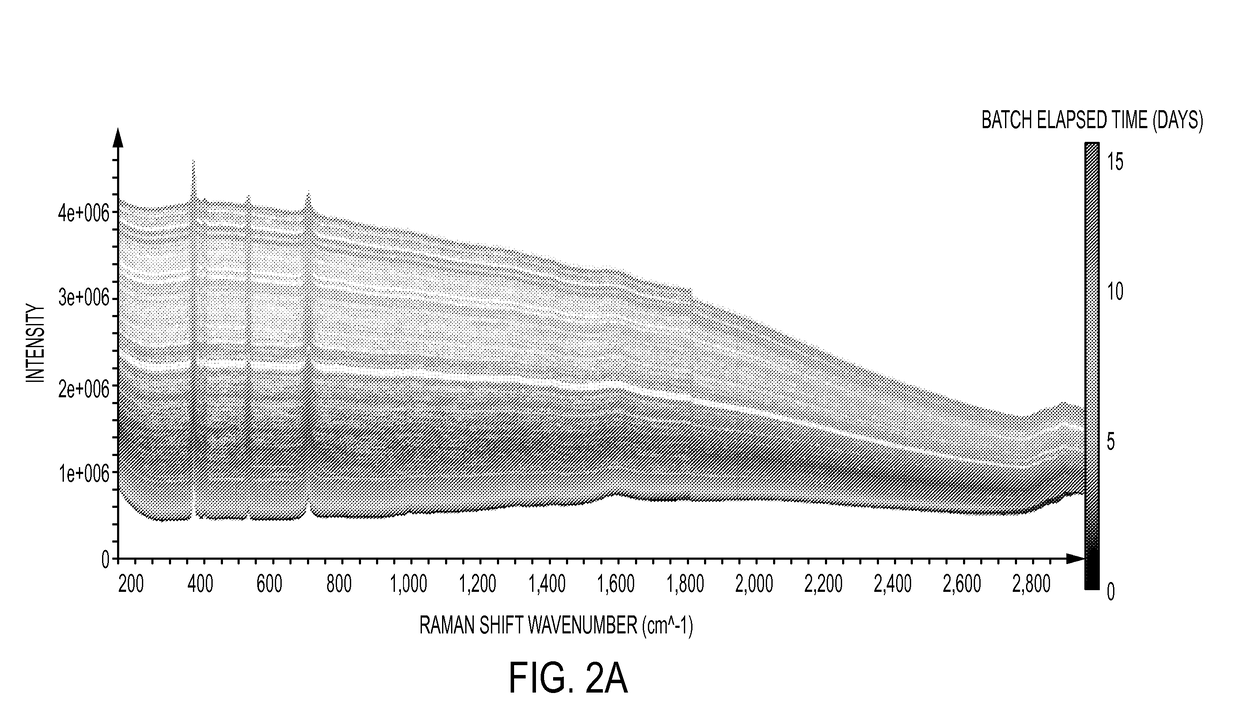Cross-scale modeling of bioreactor cultures using raman spectroscopy
a bioreactor and cross-scale technology, applied in the field of cross-scale modeling of bioreactor cultures using raman spectroscopy, to achieve the effect of predicting process performan
- Summary
- Abstract
- Description
- Claims
- Application Information
AI Technical Summary
Benefits of technology
Problems solved by technology
Method used
Image
Examples
example 1
and Methods
Bioreactor Cultures
[0241]Twenty cell culture process runs across three different stirred-tank bioreactor scales were used: 5 L Applikon (Applikon Biotechnology, The Netherlands) bench-scale glass bioreactors (n=13), 200 L custom ABEC (ABEC Inc., Bethlehem, Pa.) pilot-scale stainless steel bioreactors (n=4), and 2000 L custom ABEC manufacturing-scale stainless steel bioreactors (n=3). Here, a 13 day fed-batch process producing a monoclonal antibody via a CHO cell line is described. The process utilizes a proprietary chemically defined basal media solution with fixed amounts of daily nutrient feed (also chemically defined) and an option to add additional glucose stock if necessary, based on batch performance. The pH, temperature, and dissolved oxygen were controlled.
[0242]Bench-scale 5 L runs varied key process parameters to build process robustness into the dataset including +10% high volume feed (n=2), −10% low volume feed (n=2), +25% high initial seed density (n=3), and ...
example 2
cific Modeling
[0246]An assessment of the scale-up predictability of the technology was performed using six dataset combinations targeting permutations of the process scales (5 L, 200 L, and 2,000 L) to generate PLS calibration models which were evaluated while targeting a manufacturing-scale batch as a validation data set.
[0247]For each offline measured Y-block component, calibration data sets were created using the following scenarios: bench-scale data only, pilot-scale data only, bench-scale plus pilot-scale data, bench-scale plus pilot-scale data plus manufacturing-scale data. In one scenario, three iterations were created in order to use each of the three manufacturing data sets as an external validation set while including the other two. PLS model calibration statistics of these six designs, tracking parameters such as number of sample observations used (to reflect the size of the calibration models as well as the extent of dataset reduction resulting from outlier removal steps...
example 3
ssessment
[0252]Raman spectroscopy was used for prediction of lactate levels in a bioreactor culture. Sodium L-lactate solution, procured from SIGMA (>99% sodium L-lactate P / N 71718), was spiked into chemically defined cell culture media. The L-Lactate is representative of the lactate secreted by our cells, as opposed to D-Lactate. Sodium L-lactate was used instead of lactic acid so only an increase in sodium ions rather than hydroxide was created, which would affect the pH controlled 3 L bioreactor vessel.
[0253]The experiment was executed in a 3 L glass bioreactor vessel at process temperature (37 C), controlled between 6.9-7.0 pH, using cell free chemically defined basal media, and Raman probes installed. The spiking solution used was the same chemically defined basal media formulation with 20 g / L of the sodium L-lactate solution added into the formulation to minimize the amount of dilution occurring with other components in the basal media. Raw Raman spectra were collected between...
PUM
 Login to View More
Login to View More Abstract
Description
Claims
Application Information
 Login to View More
Login to View More - R&D
- Intellectual Property
- Life Sciences
- Materials
- Tech Scout
- Unparalleled Data Quality
- Higher Quality Content
- 60% Fewer Hallucinations
Browse by: Latest US Patents, China's latest patents, Technical Efficacy Thesaurus, Application Domain, Technology Topic, Popular Technical Reports.
© 2025 PatSnap. All rights reserved.Legal|Privacy policy|Modern Slavery Act Transparency Statement|Sitemap|About US| Contact US: help@patsnap.com



